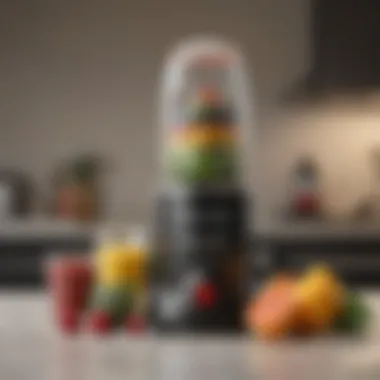Understanding the Cost of a Magic Bullet Blender


Intro
Understanding the financial implications of purchasing a Magic Bullet blender requires careful consideration of several variables. This investigation is not merely about the sticker price on the box; it involves grasping the intricacies of different models, evaluating retailer pricing, and discerning opportunities for discounts. For many, the decision to invest in such a kitchen appliance hinges on practical elements like warranty and accessories, as well as user reviews that can impact functionality and satisfaction.
With the plethora of models available, shoppers may find themselves in a dilemma regarding which features justify the cost. The analysis below attempts to provide clarity, aiming to equip potential buyers with comprehensive knowledge that extends beyond mere cost to consider value. This exploration is significant for any consumer looking to integrate the Magic Bullet blender into their culinary repertoire.
Prelims to the Magic Bullet Blender
The Magic Bullet Blender represents a significant evolution in kitchen appliances, designed for those who seek efficiency without compromising on convenience. Given its popularity, understanding the details of this appliance is crucial for potential buyers. Knowing the characteristics, capabilities, and the cost framework surrounding the Magic Bullet can influence consumer decisions in notable ways.
This section serves to unravel the importance of the Magic Bullet Blender within the larger context of kitchen equipment. As a versatile tool, it offers various functions ranging from blending to chopping, making meal preparation faster and more accessible. Additionally, consumer insight surrounding this appliance reveals trends in user satisfaction, common concerns, and preferences that can shape future models.
What is a Magic Bullet?
The Magic Bullet is a compact, high-speed blender that stands out due to its unique design and functionality. Unlike traditional blenders, it combines a sleek footprint with the capability to perform multiple tasks. With a design inspired by a bullet shape, it enables the user to blend, chop, grind, and puree with ease.
Initially marketed for its ability to make smoothies quickly, it has evolved to cater to a wider audience and various culinary ventures. The convenience of its size appeals to food lovers who desire functionality and efficiency, particularly in kitchens with limited space. Users can prepare individual servings, which promotes portion control and reduces waste.
Key Features and Specifications
Understanding the specifications and features of the Magic Bullet Blender is essential for evaluating its cost-effectiveness. Key elements include:
- Motor Power: Most Magic Bullet models feature a motor power ranging from 200 to 600 watts, which influences blending efficiency.
- Capacity: The blending cups are generally small, holding between 12 and 18 ounces, suitable for personal servings.
- Design: Its compact nature allows easy storage, making it ideal for those with limited kitchen counter space.
- Ease of Use: The user-friendly interface, often involving simple push-down operation, allows even beginners to navigate without difficulty.
- Dishwasher Safe: Most components can be washed in a dishwasher, enhancing convenience for the user.
In comparing the Magic Bullet with larger blenders, the focus on specific features such as size, versatility, and ease of use suggests that it serves a niche market where functionality and space considerations are paramount. This makes it a practical choice for many, further solidifying its position in the kitchen appliance landscape.
Exploring the Cost of a Magic Bullet
Understanding the cost of a Magic Bullet blender is essential for potential buyers who want to make an informed choice. The price you pay reflects not only the quality and features of the product but also the long-term value it provides. Evaluating the cost involves more than just looking at the base price. Considerations such as model differences, retailer pricing strategies, and additional costs can significantly impact your overall investment. Therefore, a comprehensive analysis of these factors allows consumers to see beyond the initial price tag and appreciate what they get in return.
Base Price of Magic Bullet Models
The base price of Magic Bullet models varies widely. Typically, entry-level models start around $30, while more advanced versions can reach upwards of $100. The Magic Bullet Original model is often sold at a lower price, emphasizing affordability. However, higher-end models such as the Magic Bullet Ninja will generally come with increased capabilities and features, justifying their higher cost.
Price is affected by various aspects including design, blending power, and included accessories. The broader bullet-style blender market, where Magic Bullet competes, also provides alternative price points, thereby influencing consumer expectations and acceptance of price.
Cost Variations Between Models


Variations in cost between Magic Bullet models relate directly to their unique features. For example, the Magic Bullet Blender, with its simple design for smoothies and soups, will often have a more budget-friendly price. Conversely, models like the Magic Bullet Pro, which offer higher wattage and larger capacity, come at a premium.
- Standard Models: These provide fundamental blending capabilities and are often the cheapest.
- Upgraded Models: Such as the Magic Bullet Pro, are designed for more professional use and include features that can justify a significantly higher price.
- Specialty Versions: These might offer built-in programs for certain tasks like grinding or chopping, increasing their sale price further.
Understanding these cost variations is key. It reflects not only the immediate financial implications but also the potential utility and longevity of the product in your kitchen. Each model has its distinctive characteristics to cater to different culinary needs.
Factors Influencing Pricing
Understanding the various factors that influence the pricing of a Magic Bullet blender is essential for making informed purchase decisions. To grasp the overall cost, one must consider not just the base price of the blender but also the dynamics that can impact its final cost. Each factor can add a layer of complexity to the purchasing process, affecting how much you ultimately spend. By analyzing these elements, consumers can better navigate their options and avoid unexpected costs.
Retailer Markup
Retailer markup refers to the additional cost that retailers add to the base price of a product to cover various expenses and make a profit. This markup can vary widely among different retailers. For instance, large retail chains might offer lower markups due to higher volumes of sales, while smaller shops may have higher markups as they might not sell as many units.
When considering where to buy a Magic Bullet, it is useful to compare prices across multiple retailers. Online platforms such as Amazon and physical stores like Walmart or Target might list different prices for the same model. In addition, store exclusives or special bundles may offer unique pricing opportunities. Therefore, checking various sources for the most competitive prices should be an integral part of the purchasing journey.
Seasonal Discounts and Promotions
Seasonal discounts and promotional offers can significantly affect the final price of a Magic Bullet blender. Major holidays such as Black Friday, Cyber Monday, or even summer sales often bring attractive discounts. Retailers tend to provide compelling promotions around these times, aiming to boost sales. Customers can capitalize on these events to purchase blenders at a reduced price.
Moreover, specific promotional campaigns may target new customers or encourage bulk purchases. Subscribing to newsletters from retailers can keep consumers updated on upcoming sales or exclusive offers, which can provide substantial savings. As consumers are looking to make informed decisions, tracking seasonal patterns of buying can enhance the overall shopping experience.
Geographical Price Fluctuations
Geographical price fluctuations emerge due to differences in regional costs, demand, and competition. The price of a Magic Bullet blender can change based on where you live. For example, urban areas with more competition among retailers may lead to lower prices, while rural areas may witness higher prices due to fewer options available to consumers.
Additionally, shipping costs can add another layer to physical products. If a blender is ordered online, shipping fees may vary depending on the buyer's location. Local taxes are also a factor; depending on jurisdiction, they can substantially raise the final price. Therefore, before committing to a purchase, it is crucial for buyers to consider the geographical aspect and analyze prices within their region to discover the best deal.
"By being aware of these factors influencing pricing, consumers can make smarter, more economical purchases."
An informed approach to purchasing a Magic Bullet blender considers these elements carefully, allowing consumers to maximize their investment.
Comparative Analysis with Other Blenders
Understanding the cost of a Magic Bullet blender entails more than just looking at its price tag. It is crucial to examine how it stands against other blending options available in the market. This comparative analysis highlights key competitors, their features, and the value they provide, enabling consumers to make informed decisions. An evaluation of various alternatives helps identify whether the Magic Bullet offers the best performance and pricing for potential buyers.
Key Competitors in the Market


The blender market is diverse, featuring several brands and models that compete with the Magic Bullet. Some of the notable competitors include:
- Ninja: Known for their powerful motors and larger capacity, Ninja blenders are often preferred for making smoothies and soups.
- Vitamix: This brand offers high-end blenders that are multifunctional with superior blending capabilities, though they come at a significantly higher price.
- Hamilton Beach: A more budget-friendly option, Hamilton Beach provides a variety of blenders that are decent for casual users.
- Breville: Known for its sleek design and technology, Breville blenders typically feature advanced blending programs for precision.
Examining these competitors gives a broader perspective on what consumers can expect from each option. The Magic Bullet is marketed as a quick solution for small tasks, while brands like Vitamix and Ninja cater to consumers needing more robust performance.
Price Range of Alternative Brands
When considering the price range of alternative brands compared to the Magic Bullet, it becomes clear that prices can vary widely.
- Ninja: Prices range from $70 to $200 depending on the model and its capabilities.
- Vitamix: Typically prices start around $350 and can exceed $700 for professional models.
- Hamilton Beach: More affordable with prices usually between $30 and $100.
- Breville: These blenders generally range from $100 to $500.
The Magic Bullet usually retails around $40 to $60, making it an accessible choice. However, assessing the features, motor power, and warranty options is essential when deciding if the lower initial cost translates to true value in the long run.
Evaluating these factors ensures buyers understand the trade-offs they are making when choosing a blender. Each brand has its strengths, and knowing these can greatly impact a consumer's choice.
Additional Costs Beyond the Initial Purchase
When evaluating the cost of a Magic Bullet Blender, potential buyers often focus on the initial outlay. However, it's crucial to consider the additional expenses that may arise after the purchase. Understanding these costs will enable buyers to make a more informed decision. These costs can include accessories, replacement parts, and warranty options, which can enhance the blender's utility and life span.
Accessories and Attachments
Accessories and attachments play a significant role in maximizing the functionality of a Magic Bullet Blender. While the base model comes with certain containers and blades, buyers may find it beneficial to invest in additional accessories. These can include:
- Extra Containers: Having multiple blending cups can save time during meal preparation. More containers enable users to make different recipes without the need to clean the same cup repeatedly.
- Specialized Blades: Depending on individual needs, versions of blades designed for different tasks, like chopping or grinding, may extend the blender's versatility.
- Recipe Booklets: Some purchases may include dedicated cookbooks or recipe guides that offer inspiration for new uses.
Investing in these accessories can incur extra costs but also enhances the user experience. Ultimately, the decision about which accessories to purchase will depend on personal preferences and how often the blender will be used for various tasks.
Warranty and Service Plans
The warranty and service plans associated with a Magic Bullet Blender can also contribute to total ownership costs. Generally, the standard warranty offers basic coverage for a limited time. Here are key points to consider:
- Duration of Warranty: Most brands provide a warranty ranging from one to three years. Buyers should evaluate if this is suitable for their usage patterns.
- Extended Service Plans: Manufacturers or retailers may offer extended warranties that cover repairs beyond the standard period. While these plans can offer peace of mind, they come at an additional cost.
- Repair and Replacement Costs: If an appliance does require repair post-warranty, service fees can be substantial. Understanding repair costs can inform the decision to purchase extended coverage.
Informed consumers will see value in warranties and service plans as a way to mitigate potential future expenses, ensuring that their investment remains protected.
When evaluating the total cost of a Magic Bullet Blender, include the potential fees associated with accessories and warranty plans in the overall budget. Such considerations are vital for a comprehensive understanding of what owning the appliance entails.


Consumer Insights and Reviews
Understanding consumer insights and reviews is vital when evaluating the cost of a Magic Bullet blender. These insights often serve as a reality check for potential buyers. They provide a glimpse into the actual user experience, offering a perspective that is more authentic than promotional materials.
User Satisfaction Ratings
User satisfaction ratings can reveal a great deal about how well the Magic Bullet performs in real-world applications. Many reviews across platforms like Reddit detail users' experiences after their purchase. High ratings typically indicate that a product meets or exceeds expectations concerning performance, ease of use, and durability.
- Performance: Users frequently comment on how the Magic Bullet is efficient for smoothies, sauces, and other blended items. Those who appreciate its speed and effectiveness give higher ratings.
- Ease of Use: The design of the Magic Bullet simplifies the blending process. Many reviews point out how easy it is to clean and assemble the components. Satisfaction in this area contributes to overall favorable ratings.
When looking to purchase a Magic Bullet, seek out ratings from credible sources. Sites such as Wikipedia or Britannica can provide a well-rounded view.
Common Complaints and Issues
While many users have had positive experiences, some common complaints tend to surface in reviews. Addressing these concerns can help prospective buyers make informed decisions.
- Durability: A notable number of consumers mention issues with the longevity of the product. Some users report that the blades may dull after extensive use.
- Noise Level: Numerous reviews highlight the noise produced by the blender. For some users, this aspect detracts from the overall experience, particularly for those who blend early in the morning or late at night.
- Size Limitations: Some users find that the cup sizes are smaller than what they desired. This may require multiple blending sessions for larger batches, which can be inconvenient.
These insights and complaints provide a balanced view for any potential buyer. By taking these user reviews into account, one can weigh the advantages against the drawbacks before making a financial commitment to the Magic Bullet blender.
End
The conclusion serves as a critical element in this article, summarizing the comprehensive insights into the costs associated with a Magic Bullet blender. Understanding the nuances of pricing is essential for consumers who are evaluating their options. It synthesizes the various aspects covered, presenting a holistic view of not only the financial investment but also the practical considerations that come with purchasing this kitchen appliance.
The discussion highlights that the initial price of a Magic Bullet model is only part of the overall cost equation. Factors like retailer markups, seasonal discounts, and geographical price variations play a significant role in the ultimate purchase decision. Additional expenses such as accessories and warranties can influence long-term ownership costs and satisfaction.
In evaluating the investment value, consumers must weigh the functionality and performance of the product against its price. A well-informed buyer will consider how often they will use the blender, the versatility of its features, and any potential savings from preparing meals at home versus dining out.
"Making an informed decision can enhance your experience and satisfaction with the product, saving both money and time in the long run."
This article has sought to provide clear, practical insights for potential buyers to facilitate a well-rounded decision. By synthesizing user experiences, cost factors, and competitive pricing, the conclusion not only wraps up the key points discussed but also reinforces the importance of thorough research before making any kitchen appliance purchases.
Final Thoughts on Investment Value
When considering the investment value of a Magic Bullet blender, it is vital to assess how well it meets individual needs. Different models may offer various features that appeal to diverse consumers. For instance, some individuals might appreciate the compact nature and ease of storage, while others may prioritize performance in blending harder ingredients. This assessment can guide potential buyers to determine whether the price aligns with the utility they can derive from the blender.
Recommendations for Potential Buyers
For those contemplating the purchase of a Magic Bullet blender, here are several recommendations:
- Research Models: Examine the specifications and features of different Magic Bullet models. Ensure that the selected model fits your cooking style.
- Look for Discounts: Take advantage of seasonal sales and promotions. Discounts can significantly lower the upfront costs.
- Read User Reviews: Explore consumer feedback and testimonials. Understanding common complaints can provide insight into potential issues before purchasing.
- Consider Long-Term Costs: Factor in additional costs like accessories and extended warranties. These can affect your budget over time.
- Evaluate Alternatives: Investigate other blender brands and models. Comparative analysis may reveal better options based on price and performance.
Ultimately, making a thoughtful and informed purchase consciously balances cost with functionality, ensuring maximum satisfaction for culinary pursuits.















